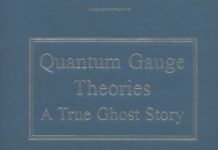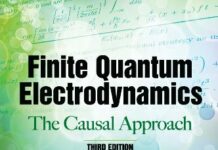
Ebook Info
- Published: 2016
- Number of pages: 320 pages
- Format: PDF
- File Size: 32.93 MB
- Authors: Gunter Scharf
Description
One of the main problems of theoretical physics concerns the unification of gravity with quantum theory. This monograph examines unification by means of the appropriate formulation of quantum gauge invariance. Suitable for advanced undergraduates and graduate students of physics, the treatment requires a basic knowledge of quantum mechanics.Opening chapters introduce the free quantum fields and prepare the field for the gauge structure, describing the inductive construction of the time-ordered products by causal perturbation theory. The analysis of causal gauge invariance follows, with considerations of massless and massive spin-1 gauge fields. Succeeding chapters explore the construction of spin-2 gauge theories, concluding with an examination of nongeometric general relativity that offers an innovate approach to gravity and cosmology.
User’s Reviews
Editorial Reviews: From the Back Cover One of the main problems of theoretical physics concerns the unification of gravity with quantum theory. This monograph examines unification by means of the appropriate formulation of quantum gauge invariance. Suitable for advanced undergraduates and graduate students of physics, the treatment requires a basic knowledge of quantum mechanics.Opening chapters introduce the free quantum fields and prepare the field for the gauge structure, describing the inductive construction of the time-ordered products by causal perturbation theory. The analysis of causal gauge invariance follows, with considerations of massless and massive spin-1 gauge fields. Succeeding chapters explore the construction of spin-2 gauge theories, concluding with an examination of nongeometric general relativity that offers an innovate approach to gravity and cosmology.Dover (2016) revised third edition of Quantum Gauge Theories―A True Ghost Story, New York, John Wiley & Sons, Inc., 2001. www.doverpublications.com About the Author Günter Scharf is Professor Emeritus of Physics at the University of Zurich. His other Dover book is the third edition of Finite Quantum Electrodynamics: The Causal Approach.
Reviews from Amazon users which were colected at the time this book was published on the website:
⭐To read this radical approach to particle physics and gravity, you will need a strong background in QFT, especially QED and gauge theory. This is a research-level monograph, not a first introduction to gauge theories, although there are problem sets at the end of each chapter. Chapters 1 to 4 on spin-1 gauge theory should be familiar from other QFT books. (Spin-1 elementary particles are experimental realities after all.) But chapters 5 and 6 on spin-2 gauge fields and gravity contain many shocking unorthodox conclusions about cosmology. If the author is right, the entire cosmology literature will need to be rewritten from scratch.For the QED prerequisite, you could use Günter Scharf’s own book, ”
⭐”. There’s almost nothing in this book explicitly about QCD, although chapter 3 is about spin-1 massless gauge fields. (If you don’t know what QFT, QED, QCD and GR mean, this is not the book for you at this time in your life!)This book, which is a 2016 updated third edition of a 2001 book, uses flat Minkowski space for the underlying space-time instead of the GR pseudo-Riemannian manifold. When combined with spin-2 gauge fields, this yields “GR without GR” in Chapter 6. (In other words, “non-geometric GR”.) The author implies on pages iii and 247-248 that this Minkowski space-time approach, where the metric tensor field is regarded as a gauge field rather than an underlying geometric “metric” field, makes the invention of dark matter unnecessary. This non-necessity, as he states, would be advantageous if no dark matter can be found. (He jokes on page 247 about the consequences for GR of the non-existence of dark matter.) And Einstein’s geometric GR will be toast.In Chapters 3 and 4, which are not based on classical Lagrangians, the standard gauge theories are obtained anyway. As the author says on page v: “In the spin-1 case we shall recover the results of the standard theory in all details.” This seems to support the case for the author’s overall approach, which is centred on S-matrices.I have to admit that I am not a physicist myself. If you are in fact a physicist, you could write a more informative review for other physicists than what I have written here. I bought this book as part of my attempt to get a better understanding of gauge theory mathematics and how this ties in with QFT. This is a good book for this purpose because by taking a radically different approach to QFT, the author gives much greater clarity to the usual approach by questioning its assumptions.
⭐Important stuff
⭐great book
Keywords
Free Download Gauge Field Theories: Spin One and Spin Two: 100 Years After General Relativity (Dover Books on Physics) in PDF format
Gauge Field Theories: Spin One and Spin Two: 100 Years After General Relativity (Dover Books on Physics) PDF Free Download
Download Gauge Field Theories: Spin One and Spin Two: 100 Years After General Relativity (Dover Books on Physics) 2016 PDF Free
Gauge Field Theories: Spin One and Spin Two: 100 Years After General Relativity (Dover Books on Physics) 2016 PDF Free Download
Download Gauge Field Theories: Spin One and Spin Two: 100 Years After General Relativity (Dover Books on Physics) PDF
Free Download Ebook Gauge Field Theories: Spin One and Spin Two: 100 Years After General Relativity (Dover Books on Physics)

